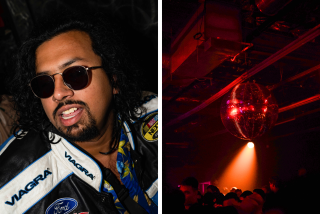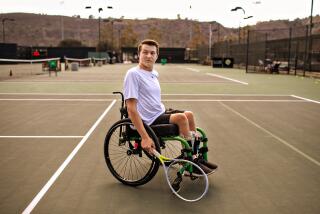Wheelchair Athlete Picazo Paints a Winning Picture : Athletics: Injured in a motorcycle accident eight years ago, Culver City resident maintains an active lifestyle.
- Share via
Joaquin Picazo of Culver City can’t get around without a wheelchair, yet doesn’t consider himself handicapped.
“Physically challenged,” Picazo said. “That’s the term I like to use.”
And it fits. Since a motorcycle accident left him wheelchair-bound eight years ago, Picazo has come to view life not in terms of impossibilities but as a series of challenges. He has maintained an active lifestyle swimming, playing tennis and basketball, and participating in 10-K races.
“I look at sports as an outlet,” Picazo said. “There are a lot of things we can do even though we’re in a chair.”
Picazo’s first exposure to wheelchair tennis came four years ago, when a friend invited him to watch a tournament.
“I picked up a racket that day, started hitting some balls and I fell in love with it,” he said. “I haven’t put the racket down since.”
A month later, using his mother’s old wooden racket, he entered the U. S. Open Wheelchair Tennis Championships, the largest event of its kind.
Picazo advanced to the third round, but more important, the competitive fire that had died out after the accident was rekindled.
Picazo is now a member of the National Foundation of Wheelchair Tennis, which sponsors tournaments, clinics, exhibitions and camps. Wheelchair tennis players follow the standard rules of the International Tennis Federation, the sole exception being that the ball can bounce twice. Picazo is in the A Division, the second-most difficult of the foundation’s five skill levels.
Picazo uses two different wheelchairs--one with a lower seat for greater speed and maneuverability for playing tennis and a higher wheelchair which is better-suited for rebounding and shooting basketballs.
Picazo likes to defy the limited expectations placed on people in wheelchairs in an effort to prove, as he likes to say, that “we can do more than roll over people’s toes.” This yearning to do the unexpected was part of Picazo’s personality long before he lost the use of his legs. In fact, it’s the reason he’s in a chair.
Picazo started racing motorcycles at 15 and turned professional two years later, becoming one of the circuit’s youngest riders. He left the sport and came back to it at 19 with high aspirations.
“I wanted to be a champion,” Picazo said. “The year I got hurt was supposed to be a promising year for me.”
That year was 1982 and Picazo was racing at Saddleback Park in Orange on a Saturday as part of the four-race California State Series. The course contained a new challenge, a triple jump.
“At first I was jumping two (jumps) and rolling over the third one,” Picazo said. “I said to myself, ‘On the last lap, I’m going to go for it and try to clear all three of them.’ There’s only a few riders who would attempt something like that, and I was one of them.”
On the final lap, Picazo accelerated as he neared the triple jump. As he went airborne, he could tell something was wrong.
“I knew once I hit it that I was a little off, but I tried to correct it in the air,” he said. “My rear wheel hit the third jump and I flipped over.
“The next thing I knew, I woke up, I was on the ground and I couldn’t move. I could move my hands, but I couldn’t move my legs.” The injury was diagnosed as a compression fracture of the T-6 vertebrae, or a broken back.
“I didn’t think I was seriously hurt at the time,” Picazo said. “I was in such good shape, I knew no matter how badly I was injured I could pop right up because of the physical strength that I had.
“I went to the hospital and the doctors told me I damaged my spinal cord. At the time, I had no idea what that meant. I said, ‘Whatever. Just patch me up so I can get back in the race on Sunday.’ They told me, ‘Joaquin, you’re never going to walk again.’
“So there I was, 21 years old, and someone was telling me that,” Picazo said. “I said, ‘No possible way. I’m not going to spend the rest of my life in a wheelchair.’ They didn’t know me; they looked at me like a statistic. There was no way I could accept that.”
Picazo began a self-designed recuperation program consisting of crawling, sit-ups and bar-assisted standing, while he visited chiropractors and acupuncturists in his native San Diego. But the results weren’t very encouraging.
“As the months went by, my legs weren’t moving and I said, ‘Wow, maybe I’m not going to walk again,’ ” Picazo said.
Thus reconciled, he didn’t waste much time adapting to his new life. He won the wheelchair division of a two-mile “fun run” six months after the accident then took up swimming, basketball and, later, tennis.
Two years ago, still in San Diego, Picazo saw a newsmagazine piece on television about the Walker Institute, an innovative rehabilitation center in the Pacific Palisades. He sent for information and, after two days of muscular and cardiovascular testing, was accepted into the program. He moved to Culver City, where he resides today.
Using electromyography, a computerized biofeedback system, the institute discovered that muscles in Picazo’s legs previously considered inactive were actually functioning, and designed a strengthening regimen for him.
Picazo has progressed to the point where he now walks 1,200 feet a day with leg braces, but says he won’t be satisfied until. . . .
“My goal is to walk without the wheelchair,” he said. “My goal is that, no matter what. I don’t have a Plan B.”
Picazo often visits schools to lecture children about sports opportunities within the physically challenged life. He recently organized a wheelchair tennis tournament in the Pacific Palisades to promote interest in the sport, and last year was named director of recreation at the Walker Institute, where he teaches tennis and basketball to other patients.
“He’s a really good instructor because he’s really patient and he’s really thorough,” said Alicia Hatorn, who has been taking lessons from Picazo since February.
Dr. Judith Walker, the institute’s founder and director of medicine, said that sports provide a necessary outlet for the patients, most of whom are between the ages of 18 and 25.
“It really gives them a lot of confidence,” Walker said. “Many people don’t think they can do it until they get the coaching.
“A lot of people in wheelchairs spend time being bored, not knowing there are things they can do. With adaptive equipment, they can do a lot of things that able-bodied people can do.”
Picazo is living proof of that. With a body that is still athletic, he deftly spins, accelerates and coasts in his chair. He would like to be a champion in tennis, but if he fails he said it will not be the end of the world. Living in a wheelchair has taught him how to keep things in perspective.
“In some ways, (the accident) is the best thing to happen to me,” Picazo said. “I used to be really into motor racing and be really arrogant, always trying to beat other people. Now I’ve learned to love. I’ve learned to share and to think about other people.”
His new outlook doesn’t go unnoticed.
“He’s real positive,” Hatorn said. “He helps all the patients to be real positive and to get more out of life. He just helps you to see that you can do whatever you want.”
Even if you’re in a wheelchair.


